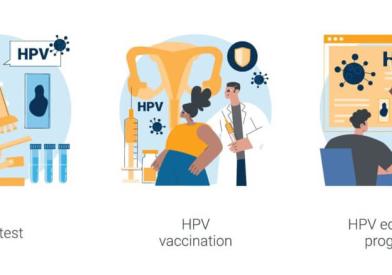What Is Cervical Cancer?
Cervical cancer is a disease in which malignant (cancer) cells form in the cervix. The cervix is the lower, narrow end of the uterus (the hollow, pear-shaped organ where a fetus grows). It leads from the uterus to the vagina (birth canal) and holds the fetus in place during pregnancy. Cervical cancer usually develops slowly over time and is pre-dated by pre-cancerous changes, which is why Pap tests have been (and continue to be) so successful in preventing cervical cancer from developing or detecting it at an early stage.
Before cancer appears in the cervix, the cells of the cervix go through changes known as dysplasia, in which cells that are not normal begin to appear in the cervical tissue. Later, cancer cells start to grow and spread more deeply into the cervix and surrounding areas, such as lymph nodes.
Risk Factors
Risk factors for cervical cancer can include:
- Human papillomavirus (HPV) infection with certain high risk subtypes
- Smoking cigarettes
- Multiple sexual partners
- Weakened immune system, such as for those with AIDS

Signs and Symptoms
Symptoms of cervical cancer may not appear until the disease is more advanced. Regular screenings are important to ensure that cervical changes are caught early, and precancerous cells are treated before they cause symptoms or develop into cancer. The signs and symptoms for cervical cancer can include:
- Vaginal bleeding
- Unusual vaginal discharge
- Pelvic pain or back pain
- Bleeding after sexual intercourse
Diagnostic Tests
- Pelvic exam
- Pap test
- Human papillomavirus (HPV) test
- Colposcopy
- Biopsy
- Endocervical curettage
- CT scan
- MRI
- PET scan
Learn details about how we diagnose cervical cancer.
Treatment
Treatment options depend on:
- The stage of the cancer
- The size of the tumor
- The patient's desire to have children
- The patient's age
- The cancer histology
- The tumor's PD-L1 status
Treatment during pregnancy depends on the stage of the cancer and the stage of the pregnancy. For cervical cancer that is found early, or for cancer found during the last trimester of pregnancy, treatment may be delayed until after the baby is born.
Learn details about how we treat cervical cancer.
Prognosis
The chance of recovery (prognosis) depends on:
- A patient's age and general health
- The stage of the cancer (whether it affects part of the cervix, involves the whole cervix, or has spread to the lymph nodes or other places in the body)
- The type of cervical cancer
- The size of the tumor




